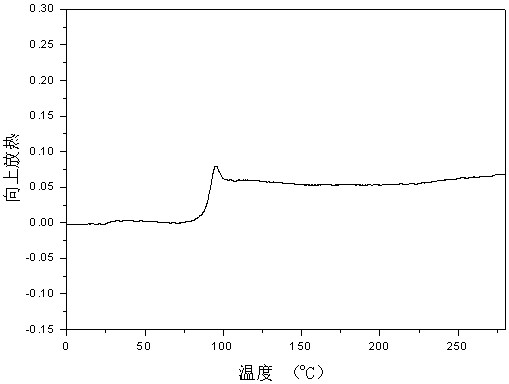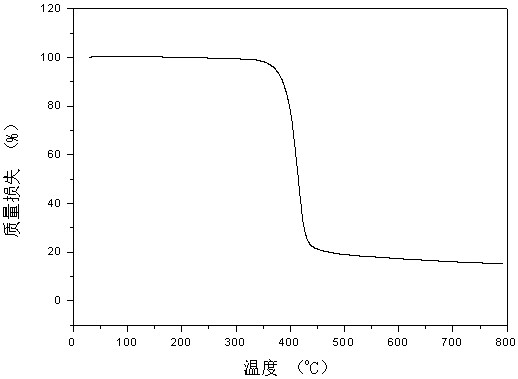Heat-resistant flame-retardant polyester, polyester product, and preparation method and application thereof
A flame-retardant polyester and heat-resistant technology, used in polyester, heat-resistant and flame-retardant polyester, polyester products and their preparation fields, can solve problems such as insufficient heat resistance and flame retardant, and achieve high dependence and excellent resistance. Effects of thermal and flame retardancy
- Summary
- Abstract
- Description
- Claims
- Application Information
AI Technical Summary
Problems solved by technology
Method used
Image
Examples
preparation example Construction
[0037] Another aspect of the embodiments of the present invention also provides a method for preparing heat-resistant and flame-retardant polyester, which includes:
[0038] Copolymerizing the first mixed reaction system comprising phosphorus-containing compound, dibasic acid and / or dibasic acid ester, dibasic alcohol, esterification and / or transesterification catalyst to obtain an intermediate product;
[0039] Making the second mixed reaction system comprising the intermediate product, polycondensation catalyst and stabilizer continue to react under vacuum conditions to obtain heat-resistant and flame-retardant polyester;
[0040] Wherein, the phosphorus-containing compound has a structure as shown in formula (I):
[0041]
[0042] Formula (I)
[0043] In formula (I), X and Y are independently selected from -OH, -OCOCH 3 or -O(CH 2 ) 2 OH,R 1 , R 2 , R 3 , R 4are independently selected from hydrogen, substituted or unsubstituted C1-C6 alkyl, substituted or unsubst...
Embodiment 1
[0117] Example 1 Dimethyl 2,5-furandicarboxylate, phosphorus-containing compound (formula (8)), ethylene glycol, and anhydrous zinc acetate were added to the reactor at a molar ratio of 1:0.3:2.0:0.001, nitrogen Under protective conditions, raise the temperature to 185°C, react for 3.5 hours, then add antimony trioxide with a molar weight of 1.0‰ of dimethyl 2,5-furandicarboxylate, and Triphenyl phosphate, the vacuum degree is 30Pa, the temperature is gradually raised to 245°C, and the reaction is carried out for 5.0 hours to obtain polyethylene-2,5-furandicarboxylate phosphorus-containing diol copolyester. The copolyester structure is shown in the following formula, 1 H-NMR (d-DMSO): δ=7.13ppm, furan ring, 2H; δ=4.55ppm, -CH 2 CH 2 -, 3.6H; δ=3.63ppm, methyl, 0.59H; δ=4.10-4.60ppm, CH, 0.1H; δ=6.41-7.72ppm, benzene ring, 1.4H. The glass transition temperature of the copolyester is 107°C, and the DSC spectrum is as follows figure 1 Shown; T in nitrogen 5% The thermal weigh...
Embodiment 2
[0120] Example 2 Dimethyl 2,5-furandicarboxylate, phosphorus-containing compound (formula (4)), ethylene glycol, and anhydrous zinc acetate were added to the reactor at a molar ratio of 1:0.05:2.1:0.0008, nitrogen Under protective conditions, raise the temperature to 190°C, react for 3 hours, then add antimony trioxide with a molar weight of 1.5‰ of dimethyl 2,5-furandicarboxylate, and phosphoric acid with a molar weight of 2,5-dimethyl furandicarboxylate of 2.0‰ Triphenyl ester, the vacuum degree is 60Pa, the temperature is gradually raised to 250°C, and the reaction is carried out for 4.0h to obtain the target product. through 1 H-NMR characterization revealed that the target product was polyethylene-2,5-furandicarboxylate phosphorus-containing diol copolyester, and its structural formula was shown in the following formula. The glass transition temperature of the copolyester is 91° C., and the flame retardancy test is V1 level.
[0121]
[0122] Wherein, m and n are int...
PUM
| Property | Measurement | Unit |
|---|---|---|
| glass transition temperature | aaaaa | aaaaa |
| thickness | aaaaa | aaaaa |
| glass transition temperature | aaaaa | aaaaa |
Abstract
Description
Claims
Application Information
 Login to View More
Login to View More - R&D
- Intellectual Property
- Life Sciences
- Materials
- Tech Scout
- Unparalleled Data Quality
- Higher Quality Content
- 60% Fewer Hallucinations
Browse by: Latest US Patents, China's latest patents, Technical Efficacy Thesaurus, Application Domain, Technology Topic, Popular Technical Reports.
© 2025 PatSnap. All rights reserved.Legal|Privacy policy|Modern Slavery Act Transparency Statement|Sitemap|About US| Contact US: help@patsnap.com



